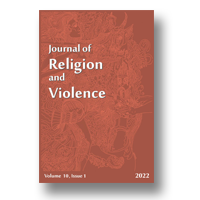|
|
|
1.
|
Journal of Religion and Violence:
Volume >
7 >
Issue: 3
Julie Ingersoll
Classification Matters:
Hiding Violence in Christianity in the United States
view |
rights & permissions
| cited by
|
|
|
|
|
articles |
|
2.
|
Journal of Religion and Violence:
Volume >
7 >
Issue: 3
Sean Durbin
Violence as Revelation:
American Christian Zionist Theodicy, and the Construction of Religion through Violence
abstract |
view |
rights & permissions
| cited by
Drawing on Russell McCutcheon’s (2003) redescription of the theological category of theodicy as a socio-political rhetoric that functions to conserve social interests, this article examines the way that American Christian Zionists employ theodicies to explain historical, contemporary, and anticipated acts of violence. It argues that violence is central to Christian Zionists’ conception of God’s revelation, and thus to their identity. Rather than requiring the intellectual wrangling often associated with religious explanations for why violence is inflicted on or by a certain group of people, Christian Zionists identify acts of violence as either God’s punishment for insufficient support for Israel, or as God’s vengeance upon those who wish to harm his chosen people. In any given context, Christian Zionists draw on acts of violence to reaffirm their truth claims, and to ensure their desired social order is maintained.
|
|
|
|
|
3.
|
Journal of Religion and Violence:
Volume >
7 >
Issue: 3
Brad Stoddard
God’s Favorite Gun:
The Sanctuary Church and the (re)Militarization of American Christianity
abstract |
view |
rights & permissions
| cited by
This article analyzes the Sanctuary Church in Pennsylvania, pastored by Reverend Hyung Jin “Sean” Moon, son of the late Reverend Sun Myung Moon. It specifically addresses the church’s history and the theology that motivated “Pastor Sean,” as he is commonly called, to host a marriage blessing ceremony where attendees brought crowns and AR-15 rifles to church. It argues that this ceremony, and Moon’s theology itself, are extensions of the unique political, cultural, and legal battles increasingly common in the United States. It also explores the church’s critics who used the blessing ceremony as an opportunity to “save” the categories of Christianity and religion from being tainted by Moon’s martial theology.
|
|
|
|
|
4.
|
Journal of Religion and Violence:
Volume >
7 >
Issue: 3
Sophie Bjork-James
Christian Nationalism and LGBTQ Structural Violence in the United States
abstract |
view |
rights & permissions
| cited by
This paper uses anti-LGBTQ bias within evangelical Christianity as a case study to explore how nationalist movements justify prejudicial positions through framing privileged groups as victims. Since Anita Bryant’s late 1970s crusade against what was dubbed the “homosexual agenda,” white evangelicals have led a national movement opposing LGBTQ rights in the United States. Through a commitment to ensuring sexual minorities are excluded from civil rights protections, white evangelicals have contributed to a cultural and legal landscape conducive to anti-LGBTQ structural violence. This opposition is most often understood as rooted in love, and not in bias or hate, as demonstrated during long-term ethnographic research among white evangelical churches in Colorado Springs. Engaging with theories of morality and nationalism, this article argues that most biased political movements understand their motivation as defending a moral order and not perpetuating bias. In this way they can justify structural violence against subordinated groups.
|
|
|
|
|
5.
|
Journal of Religion and Violence:
Volume >
7 >
Issue: 3
Richard Newton
Scared Sheetless:
Negrophobia, the Fear of God, and Justified Violence in the U.S. Christian-White Imaginary
abstract |
view |
rights & permissions
| cited by
The ideology of white supremacy is alive and well in the U.S. This paper argues that those attempting to understand how white supremacy works should delve into recent justifications of anti-black violence rather than simply waiting to spot the white sheets of the Ku Klux Klan. Doing so requires scholars to disabuse themselves of taking for granted the descriptions of what may be characterized as a U.S. Christian-White imaginary and to observe the dynamic, discursive shifts that Jean-Franc̜ois Bayart calls “operational acts of identification.” Drawing on incidents from antebellum slavery to the Black Lives Matter era and beyond, it is argued that white people have long been able to justify anti-black violence by appealing to a biblicist “Negrophobia,” wherein black people are rendered as frightening, even demonic creatures that must be stopped for the good of God’s kingdom. This paper presents a critical history of violence in America that is representative of a devastatingly effective strategy that continues to fortify the functional primacy of whiteness despite popular rejections of racism.
|
|
|
|
|
book reviews |
|
6.
|
Journal of Religion and Violence:
Volume >
7 >
Issue: 3
Thomas W. Barton
Figuring Racism in Medieval Christianity. M. Lindsay Kaplan
view |
rights & permissions
| cited by
|
|
|
|
|
7.
|
Journal of Religion and Violence:
Volume >
7 >
Issue: 3
Karl Bell
A Supernatural War: Magic, Divination, and Faith during the First World War. Owen Davies
view |
rights & permissions
| cited by
|
|
|
|
|
8.
|
Journal of Religion and Violence:
Volume >
7 >
Issue: 3
Conor Q. Foley
Reading Phinehas, Watching Slashers: Horror Theory and Numbers 25. Brandon R. Grafius
view |
rights & permissions
| cited by
|
|
|
|
|
9.
|
Journal of Religion and Violence:
Volume >
7 >
Issue: 3
Cathy Gutierrez
Children of Lucifer: The Origins of Modern Religious Satanism. Ruben van Luijk; and Satanic Feminism: Lucifer as the Liberator of Woman in Nineteenth-Century Culture. Per Faxneld
view |
rights & permissions
| cited by
|
|
|
|





